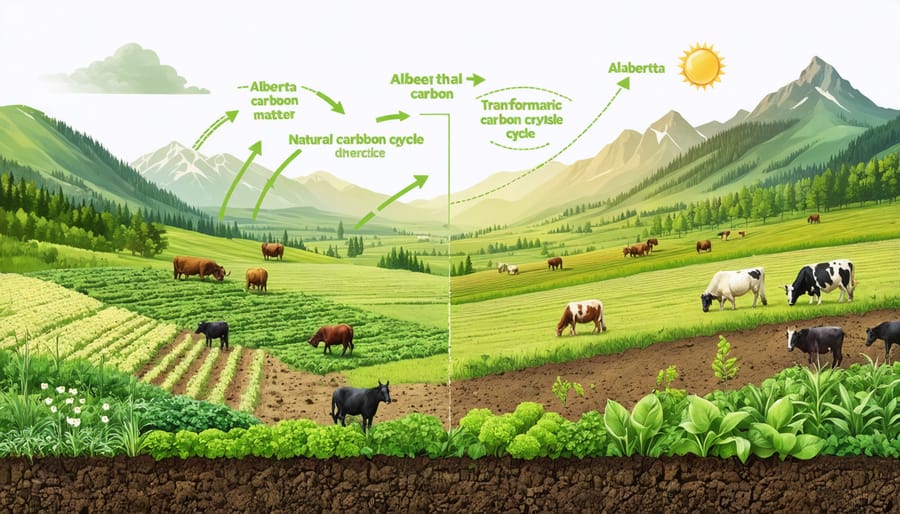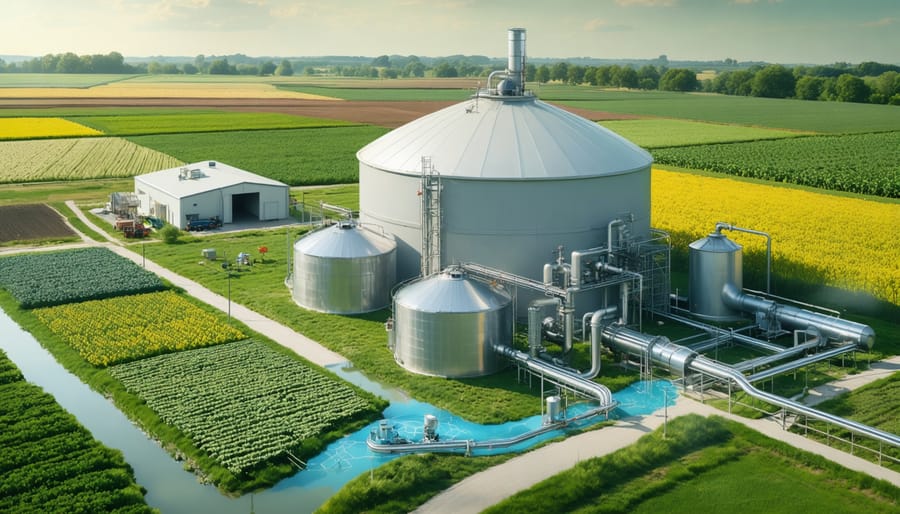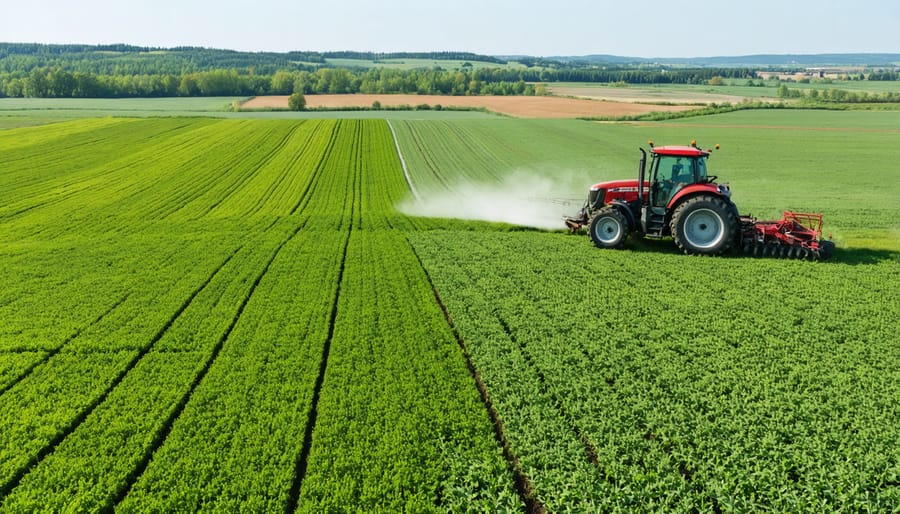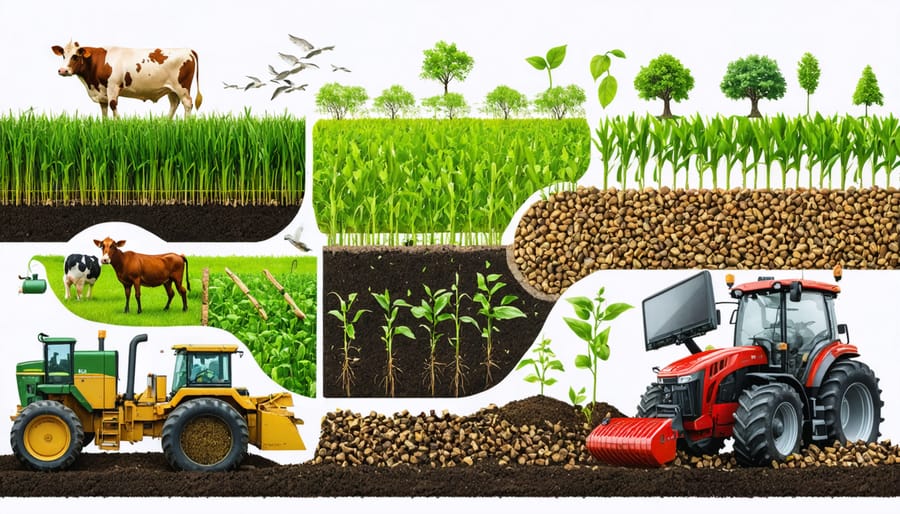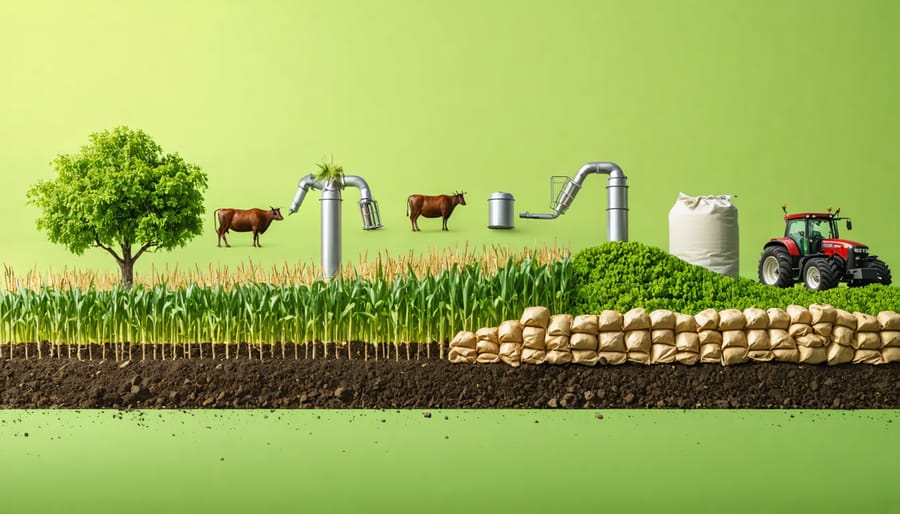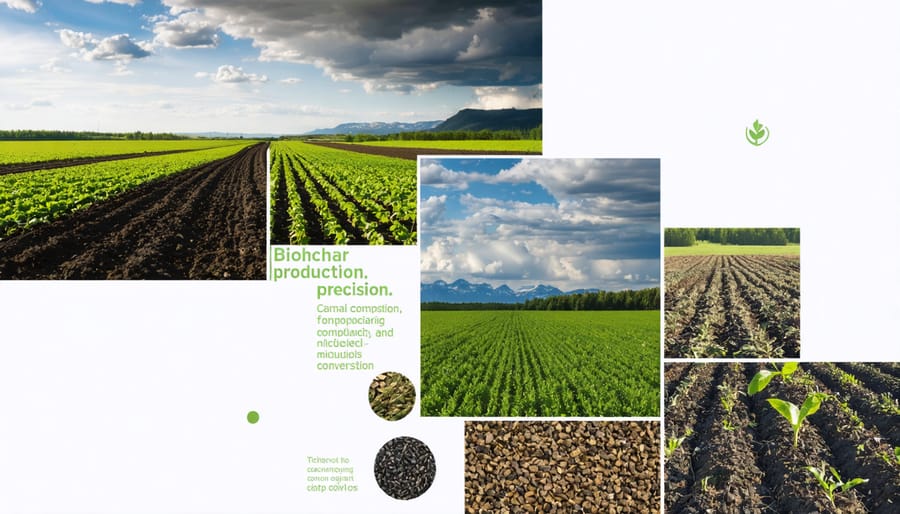Carbon cycle agriculture transforms ordinary farms into powerful carbon sinks while boosting crop yields and soil health across Alberta’s diverse landscapes. By working with nature’s own carbon-capturing systems, farmers are discovering how to build resilient operations that actively pull greenhouse gases from the atmosphere while improving their bottom line.
This regenerative approach represents a remarkable shift in how we view agricultural productivity – not just as a measure of harvest yields, but as a holistic system where soil health, carbon sequestration, and farm profitability work together in harmony. From the rich black soils of central Alberta to the prairie grasslands, producers are implementing practices that mimic natural carbon cycles, creating a win-win scenario for both the environment and their operations.
Leading Canadian research shows that farms implementing carbon cycle agriculture can sequester up to 2 tonnes of carbon per hectare annually while reducing input costs by 20-30%. This practical approach to climate-smart farming isn’t just about environmental stewardship – it’s about building stronger, more profitable agricultural businesses that will sustain future generations of Canadian farmers.
Understanding Carbon Cycle Agriculture
The Natural Carbon Cycle in Agriculture
In agricultural systems, carbon moves through a continuous cycle that connects soil, plants, and the atmosphere. Plants capture carbon dioxide from the air through photosynthesis, converting it into sugars and other organic compounds they need to grow. As crops develop, they store carbon in their leaves, stems, and roots, while also transferring some of it into the soil through root systems.
When plant materials decompose or when farmers incorporate crop residue into their fields, organic matter breaks down and enriches the soil. Beneficial microorganisms process this material, storing carbon in stable forms that can remain in the soil for years or even decades. This stored carbon improves soil structure, water retention, and nutrient availability.
The cycle continues as soil organisms release some carbon back into the atmosphere through respiration, and as farming activities like tillage expose stored soil carbon to the air. Here in Alberta, our cold winters typically slow decomposition, allowing for greater carbon storage potential in our agricultural soils. Understanding this natural cycle helps farmers work with these processes to enhance soil health while supporting productive farming operations.
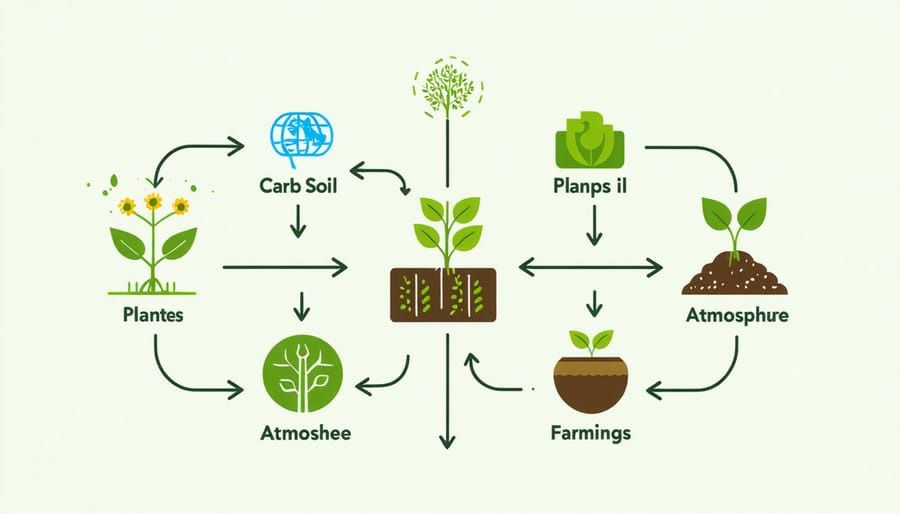
Circular Economy Integration
Carbon cycle agriculture naturally aligns with and enhances Alberta’s emerging circular agricultural revolution, creating a self-sustaining system where waste becomes a valuable resource. By implementing carbon cycling practices, farmers contribute to a closed-loop system where organic materials, nutrients, and carbon flow continuously between soil, plants, and atmosphere.
This integration manifests in practical ways across Alberta farms. Crop residues become soil amendments, livestock manure transforms into natural fertilizer, and cover crops serve dual purposes as soil builders and animal feed. These practices reduce dependency on external inputs while creating new value streams for farmers.
The circular approach extends beyond individual farms to create community-wide benefits. Local partnerships between crop and livestock producers enable resource sharing, while food processors and retailers participate by returning organic waste to agricultural lands. This system thinking helps maintain soil health, reduces waste, and strengthens local agricultural economies while naturally sequestering carbon.
For Alberta farmers, this represents a shift from linear to circular thinking, where every output becomes an input for another process, maximizing resource efficiency and environmental benefits.
Practical Implementation in Alberta Farms
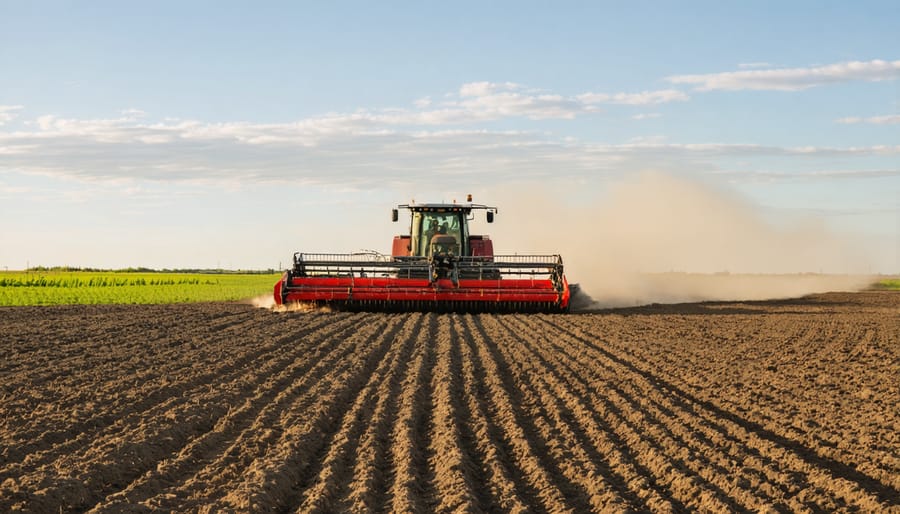
Soil Management Techniques
Effective soil management is the cornerstone of carbon cycle agriculture, and Alberta farmers have developed several proven soil enrichment systems that enhance carbon sequestration. The key lies in minimizing soil disturbance while maximizing organic matter retention.
No-till or reduced tillage practices are particularly effective in our prairie climate, helping maintain soil structure and preventing carbon loss. Combined with cover cropping, these techniques can increase soil organic carbon by 0.2 to 0.5 tonnes per hectare annually.
Crop rotation diversity plays a crucial role, with deep-rooted perennials like alfalfa being especially beneficial. These plants extend their root systems up to 2 metres deep, creating natural carbon pathways throughout the soil profile.
Composting and manure management are equally important. Local success stories show that applying well-aged compost at 10-15 tonnes per hectare can significantly boost soil carbon levels while improving water retention. Many Alberta farmers have found success with winter composting, taking advantage of our cold climate to minimize nutrient loss.
Consider implementing buffer strips and windbreaks, which not only prevent erosion but also contribute to carbon storage. These permanent vegetation areas can sequester up to 2.5 tonnes of carbon per hectare annually while protecting valuable topsoil.
Crop Selection and Rotation
Strategic crop selection and rotation are fundamental to maintaining healthy carbon cycles in Alberta’s agricultural systems. By choosing the right combination of crops and rotating them effectively, you can maximize carbon sequestration while improving soil health and crop yields.
Deep-rooted crops like alfalfa and clover are excellent carbon builders, extending up to 2 metres into the soil while fixing nitrogen naturally. These should be incorporated into your rotation every 3-4 years. For annual crops, consider including high-residue options like wheat and barley, which can contribute up to 4 tonnes of organic matter per hectare annually.
Local success stories show the benefits of diverse rotations. The Morrison family farm near Red Deer saw a 20% increase in soil organic carbon over five years by implementing a four-year rotation of canola, wheat, pulses, and cover crops. They particularly noted the value of including pulse crops like field peas and lentils, which not only fix nitrogen but also support beneficial soil microorganisms.
When planning your rotation, consider these key factors:
– Root depth variety
– Residue production
– Nitrogen-fixing capabilities
– Local climate conditions
– Market opportunities
For best results, aim for at least three different crop types in your rotation. Include both warm and cool-season crops, and consider adding cover crops during shoulder seasons to maintain living roots in the soil year-round. This approach helps maximize carbon storage while providing additional benefits like weed suppression and erosion control.
Waste Management and Composting
Effective waste management in agriculture isn’t just about disposal – it’s about transforming what we once considered waste into valuable resources that enhance soil health and farm productivity. Through composting agricultural waste, Alberta farmers are discovering innovative ways to close the carbon loop on their operations.
Crop residues, livestock manure, and other organic materials can be processed into high-quality compost that returns essential nutrients to the soil while sequestering carbon. Many Alberta producers have implemented successful on-farm composting systems, processing everything from straw and chaff to livestock bedding. These systems range from simple windrow composting to more sophisticated aerated static pile methods.
The benefits extend beyond waste reduction. Properly managed compost helps improve soil structure, increases water retention, and provides slow-release nutrients for crops. For example, the Morrison Family Farm near Red Deer reduced their fertilizer costs by 30% after implementing a comprehensive composting program for their mixed farming operation.
To get started, focus on collecting easily compostable materials and maintaining proper moisture and aeration levels. Local agricultural extension services offer guidance on optimal composting ratios and monitoring techniques. Remember, successful composting is about balance – combining nitrogen-rich materials (green waste) with carbon-rich materials (brown waste) in appropriate proportions.
Success Stories from Alberta’s Fields
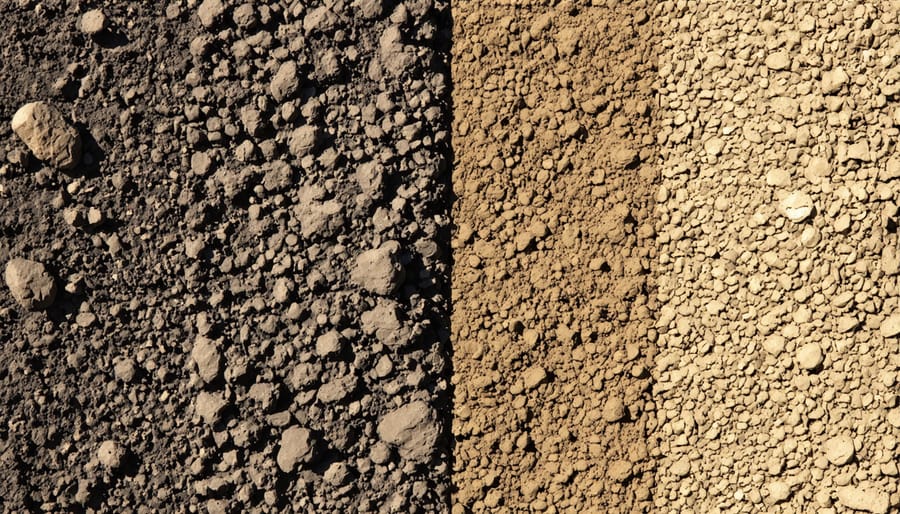
The Morrison Family Farm Transformation
Located just outside Red Deer, the Morrison Family Farm has become a shining example of successful carbon cycle agriculture implementation in Alberta. In 2018, John and Sarah Morrison made the bold decision to transition their 640-hectare grain operation to regenerative practices, focusing on enhancing soil carbon sequestration.
The Morrisons began by introducing a diverse seven-crop rotation system, including traditional wheat and canola alongside cover crops like clover and rye. They implemented no-till practices and maintained living roots in the soil year-round, which significantly improved their soil organic matter from 2% to 4.5% within three years.
Their innovative approach included integrating 200 head of cattle into their operation, using adaptive multi-paddock grazing to stimulate plant growth and enhance nutrient cycling. The cattle’s contribution to the system proved invaluable, with their manure providing natural fertilization and their grazing patterns promoting healthy root development.
The results have been remarkable. The farm has reduced its synthetic fertilizer use by 60% while maintaining comparable yields. Water retention has improved dramatically, helping them weather both drought and excessive rainfall. Most importantly, their soil tests show they’re sequestering an estimated 2.5 tonnes of carbon per hectare annually.
“The transformation wasn’t always easy,” says John Morrison, “but the improvements in soil health and reduced input costs have made it worthwhile. We’re not just farming for today; we’re building a legacy for future generations.”
Community Impact and Economic Benefits
Carbon cycle agriculture has sparked remarkable transformations in rural Alberta communities, creating ripple effects that extend far beyond individual farms. Local farmers implementing these practices report strengthened community bonds through knowledge sharing and collaborative equipment use, particularly during soil testing and composting initiatives.
In Lacombe County, a group of farmers collectively reduced input costs by 15% through shared composting facilities, while creating three new full-time positions to manage these operations. Similar success stories have emerged across central Alberta, where farming communities have established local organic matter exchange programs, benefiting both crop and livestock producers.
The economic advantages are equally compelling. Farmers practicing carbon cycle agriculture typically see a 20-30% reduction in synthetic fertilizer costs within the first three years. Many report improved crop resilience during extreme weather events, leading to more stable income streams and reduced insurance claims.
Local agricultural businesses have also adapted to support these practices, with several equipment dealers now offering specialized tools for minimal tillage and precision farming. This has created new job opportunities in rural areas, from soil health consultants to regenerative agriculture technicians.
Additionally, these practices have attracted younger generations back to farming, with several Alberta communities noting an increase in farm succession planning and new entrants to agriculture, helping to secure the future of local food production.
Getting Started with Carbon Cycle Agriculture
Initial Assessment and Planning
Before diving into carbon cycle agriculture, it’s essential to assess your farm’s current state and develop a structured implementation plan. Start by conducting a comprehensive soil test to establish baseline carbon levels and nutrient content. This information will help you track progress and make informed decisions moving forward.
Create a detailed map of your land, noting different soil types, moisture patterns, and existing vegetation. Consider factors like topography, drainage, and historical land use. These elements will influence your carbon-building strategies and help identify priority areas for implementation.
Next, evaluate your current farming practices and equipment capabilities. Many Alberta farmers find they can begin with minimal additional investment by adjusting existing operations. Document your current rotation patterns, tillage practices, and input usage to identify opportunities for improvement.
Develop a realistic timeline that accounts for seasonal variations and your farm’s operational capacity. Most successful transitions occur over 3-5 years, allowing time for soil biology to respond and systems to adjust. Consider starting with a pilot project on a smaller field to gain experience and confidence.
Connect with local agricultural extension services and experienced carbon cycle practitioners. Many Alberta farmers have successfully implemented these practices and are willing to share their insights. Remember to document your starting point with photographs and detailed notes – this will be valuable for tracking progress and potentially accessing carbon credit programs in the future.
Available Support and Resources
Alberta farmers exploring carbon cycle agriculture have access to numerous support systems and funding opportunities. The Canadian Agricultural Partnership (CAP) offers grants of up to $50,000 for implementing sustainable fertilizer practices and soil management techniques.
Local Agricultural Service Boards (ASBs) provide free consultations and soil testing services, helping farmers develop tailored carbon management strategies. The Alberta Farm Sustainability Extension Working Group (AFSEWG) offers workshops and field demonstrations throughout the growing season.
Financial assistance is available through various channels:
– Environmental Farm Plan grants (up to $10,000)
– Agriculture Financial Services Corporation (AFSC) sustainability loans
– Carbon credit programs through the Alberta Carbon Registry
Technical support can be accessed through:
– Alberta Agriculture and Forestry extension offices
– Certified crop advisors specializing in regenerative practices
– Regional soil health laboratories
– Local farmer-led research associations
The Agricultural Research and Extension Council of Alberta (ARECA) connects farmers with peer networks and mentorship opportunities. Additionally, several agricultural colleges across the province offer professional development courses focused on carbon cycle management.
For immediate assistance, farmers can contact their nearest agriculture fieldman or visit their local AFSC office to explore available programs and funding options.
Carbon cycle agriculture represents a vital opportunity for Alberta’s farming community to lead the way in sustainable agriculture while building more resilient operations. By implementing practices like cover cropping, reduced tillage, and rotational grazing, farmers across our province are already seeing improvements in soil health, water retention, and crop yields. These benefits extend beyond individual farms to contribute to our broader environmental goals and economic stability.
As we’ve seen through local success stories, the transition to carbon cycle agriculture is both practical and profitable. Whether you’re managing a large-scale operation or a family farm, every step toward better carbon management counts. We encourage you to start small, learn from your fellow farmers, and gradually expand your sustainable practices. Together, we can build a stronger, more sustainable agricultural future for Alberta while maintaining our position as global leaders in agricultural innovation.

